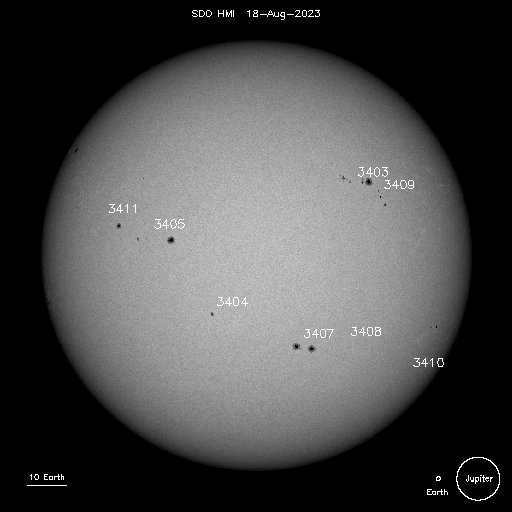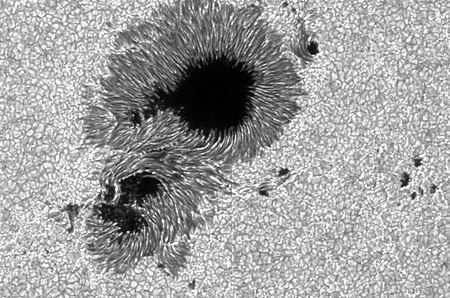
Sunspots are dark regions on the surface of the Sun that have a lower temperature compared to the surrounding areas of the photosphere, with a difference of about 1500 K. These spots can be observed on the Sun’s disk using optical instruments, and sometimes even with the naked eye, especially when they are large. They appear as dark spots. Sunspots are formed in areas where intense magnetic fields (up to several thousand gauss) emerge on the surface of the photosphere. The darkening of the photosphere in these spots is caused by the magnetic field suppressing the convective movements of matter, resulting in a decrease in the transfer of thermal energy in those specific areas.
The number of sunspots, and the associated Wolf number, is a significant indicator of solar magnetic activity.
Cooler stars, such as those belonging to the K class and cooler, tend to have larger sunspots compared to the Sun. [3]
Study Background
The initial documentation of sunspots can be traced back to ancient China around 800 BC.

The first depiction of these blemishes can be traced back to 1128 in the recorded history of John of Worcester. [4]
The initial documented reference to sunspots in ancient Russian literature can be found in the Nikon Chronicle, in entries dating back to the latter half of the 14th century: [5]
there was a celestial indication, the sun had a blood-like appearance, and there were dark spots present on its surface.
there was a celestial indication, and the spots appeared as dark as nails on the sun, causing a significant darkness.
The era of instrumental study of the Sun began in 1610. The invention of the telescope and its special variant for observing the Sun, the helioscope, enabled scientists such as Galileo, Thomas Herriot, and Christoph Scheiner to observe sunspots. Galileo was the first to realize that sunspots were a part of the solar structure, while Scheiner believed they were planets passing in front of the Sun. This realization allowed Galileo to discover the Sun’s rotation and calculate its period. The discovery of the spots and their nature was the subject of a lengthy debate between Galileo and Scheiner, but it is likely that neither of them was the first to observe or publish about them.
The initial investigations were focused on the characteristics and behavior of the sunspots. [4] Despite the fact that the true nature of the spots remained unclear until the 20th century, the observations persisted. By the 19th century, there had been a sufficient number of sunspot observations to detect periodic fluctuations in the activity of the Sun. In 1845, D. Henry and S. Alexander (Eng. S. Alexander) from Princeton University conducted observations of the Sun using a specialized thermometer (en:thermopile) and determined that the radiation intensity of sunspots is lower in comparison to the surrounding regions of the Sun. [7]
Appearance
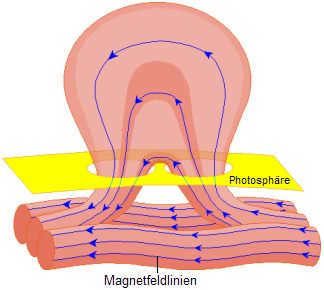
Solar spots occur due to disturbances in specific parts of the Sun’s magnetic field. In the initial stages of this process, magnetic field tubes penetrate the photosphere and extend into the corona region. The strong magnetic field restricts the convective movement of plasma in these areas, preventing the transfer of energy from the inner regions to the outer regions. This results in the formation of a plume at the affected location, followed by the development of a small spot known as a pore. These pores can span several thousand kilometers. Over time, the magnetic induction strength increases (starting from 0.1 tesla), and the number and size of pores also increase. Eventually, the pores merge together to form one or multiple spots. During the peak period of spot activity, the magnetic induction can reach up to 0.4 tesla.
The duration of spot existence can extend for several months, meaning that separate clusters of spots can be observed over multiple rotations of the Sun. It was this particular observation (the movement of the observed spots across the solar disk) that served as the foundation for the confirmation of the Sun’s rotation and facilitated the initial measurements of the Sun’s rotational period around its axis.
Spots typically form in groups, although occasionally a solitary spot may appear and only endure for a few days, or a bipolar group may emerge, consisting of two spots with differing magnetic polarities that are connected by magnetic field lines. The western spot within such a bipolar group is referred to as the “leading,” “head,” or “P-spot” (preceding), while the eastern spot is known as the “leading,” “tail,” or “F-spot” (following).
Only 50% of the sunspots have a lifespan exceeding 48 hours, and merely 10% manage to survive for more than 264 hours.
During the initial phase of the 11-year solar activity cycle, sunspots emerge at high heliographic latitudes (approximately ±25-30°), and as the cycle progresses, they gradually migrate towards the solar equator, ultimately reaching latitudes of ±5-10° by the cycle’s end. This predictable pattern is known as “Spörer’s law”.
Sunspot groups typically align themselves parallel to the solar equator, but there is a slight inclination of the group axis in relation to the equator. This inclination tends to increase for groups situated further from the equator, a phenomenon referred to as “Joy’s law”.
Characteristics
The Sun possesses various properties. Its average surface temperature is approximately 6000 K, with an effective temperature of 5770 K and a radiative temperature of 6050 K. The central area of sunspots, which is the darkest region, has a temperature of around 4000 K. The outer regions of the sunspots, which border the normal surface, have temperatures ranging from 5000 to 5500 K. Despite the lower temperature, the matter within the sunspots still emits light, although not as much as the rest of the surface. This temperature difference gives the impression that the sunspots are dark or almost black. However, they are actually emitting light, but their luminescence is overshadowed by the brighter solar disk.
The central dark region of the spot is referred to as the shadow. It typically has a diameter of about 0.4 times the diameter of the spot. Within the shadow, the magnetic field strength and temperature are relatively uniform, and the intensity of visible light emission is 5-15% of the value observed on the photosphere. Surrounding the shadow is a penumbra composed of alternating light and dark radial fibers, with luminosity intensities ranging from 60 to 95% of the photospheric luminosity. [8]
In the area of the Sun where the spot is located, the surface is approximately 500-700 km lower than the surface of the surrounding photosphere. This phenomenon is known as the “Wilson depression”.
Spots on the Sun represent the areas with the highest level of activity. In the event that there are numerous spots, the likelihood of magnetic lines reconnecting increases. This reconnection occurs when lines from one group of spots combine with lines from another group of spots that have an opposite polarity. The outcome of this process is the occurrence of a solar flare. As a result, a burst of radiation is emitted towards the Earth, which leads to significant disruptions in its magnetic field. These disruptions can cause disturbances in the operation of satellites and even impact objects located on the planet. Additionally, these disturbances in the Earth’s magnetic field also enhance the possibility of witnessing the northern lights at lower geographic latitudes. Furthermore, fluctuations in solar activity also affect the Earth’s ionosphere, resulting in changes in the propagation of short radio waves.
Sorting
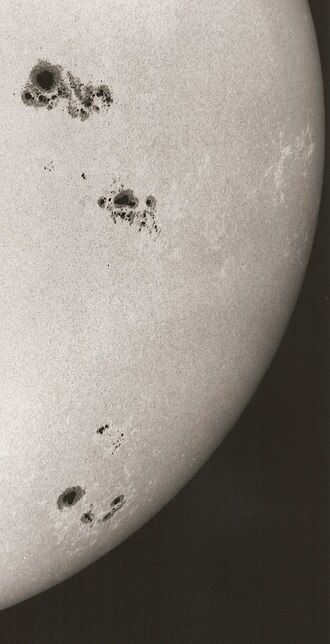
The classification of sunspots is based on their duration, dimensions, and placement.
Phases of progress
As previously mentioned, the enhancement of the local magnetic field hampers the movement of plasma within convection cells, resulting in the deceleration of heat transfer to the Sun’s surface. The cooling of granules affected by this process (by approximately 1000 °C) causes them to darken and forms a solitary spot. Some of these spots vanish after a few days, while others evolve into bipolar groups consisting of two spots with opposite magnetic polarities. These groups can further coalesce into larger clusters of spots, which, if the penumbra area continues to expand, can grow to encompass hundreds of spots spanning hundreds of thousands of kilometers. Subsequently, there is a gradual (over several weeks or months) decline in spot activity and a decrease in their size to small double or single spots.
The biggest collections of spots always have a corresponding collection in the opposite hemisphere (either northern or southern). In such cases, magnetic lines depart from the spots in one hemisphere and enter into the spots in the other.
Spots Group Sizes
The size of a spot group is typically characterized by its geometric size, as well as the number of spots it contains and their overall area.
A group can consist of anywhere from one to one and a half hundred or more spots. The areas of these groups, which are conveniently measured in millionths of the solar hemisphere area (m.s.p.), can range from a few m.s.p. to several thousand m.s.p..
The largest area recorded during the entire period of continuous sunspot observations (from 1874 to 2012) was attributed to a sunspot group with the catalog number 1488603 (Greenwich catalog). This group first appeared on the Sun’s disk on March 30, 1947, during the peak of the 18th 11-year cycle of solar activity. By April 8, its total area had reached 6132 m.s.p. (1.87-10^10 km²), which is more than 36 times the area of the Earth. [9] At its maximum development, this group consisted of over 170 individual sunspots. [10]
Cyclicity
The cyclicity of the Sun is connected to the frequency, activity, and lifespan of sunspots. The duration of one cycle is about 11 years. In times of low activity, there are hardly any or no sunspots visible on the Sun, whereas during a peak, hundreds can be seen. At the conclusion of each cycle, the polarity of the Sun’s magnetic field flips, leading to a more accurate description of a 22-year solar cycle.
Cycle duration
While the typical length of a solar cycle is approximately 11 years, there are variations in duration ranging from 9 to 14 years. Additionally, the average length of solar cycles has changed over the centuries. For instance, during the 20th century, the average cycle duration was recorded as 10.2 years.
The configuration of each cycle can differ. Max Waldmeier, a Swiss astronomer, proposed that the transition from the minimum to maximum solar activity occurs at a faster rate when there is a higher maximum number of sunspots observed during that particular cycle (known as the “Waldmeier rule”).
The start and conclusion of the cycle
In previous times, the commencement of a cycle was regarded as the point when solar activity reached its minimum level. With the aid of contemporary measurement techniques, it is now feasible to ascertain the alteration of the solar magnetic field’s polarity, henceforth, the moment of polarity change in sunspots is now considered as the initiation of the cycle. [source not specified 67 days]
The numbering system for cycles was suggested by R. Wolf. According to this system, the inaugural cycle commenced in 1749. In 2009, the 24th solar cycle was inaugurated.
| 18 | February 1944 | May 1947 | 201 |
| 19 | April 1954 | October 1957 | 254 |
| 20 | October 1964 | March 1968 | 125 |
| 21 | June 1976 | January 1979 | 167 |
| 22 | September 1986 | February 1989 | 165 |
| 23 | September 1996 | March 2000 | 139 |
| 24 | January 2008 | December 2012* | 87* |
There is a cyclic pattern of fluctuation in the highest count of sunspots that takes place approximately every 100 years (referred to as the “century cycle”). The most recent periods of low sunspot activity within this cycle were observed between 1800-1840 and 1890-1920. There is also speculation that there may be even longer-lasting cycles.
Additional Information
Notes
- ↑Click here to see an image of sunspots on December 13, 2006.
- ↑Check out the state of the Sun on December 13, 2006.
- ↑There was a giant sunspot on the star HD 12545.
- ↑ 12Learn about the great moments in the history of solar physics. Unfortunately, the link is unavailable. Checked February 26, 2010.
- ↑Read about the astronomy of ancient Russia by Д. О. Svyatsky.
- ↑Explore Galileo Galilei’s Letters on Sunspots. Unfortunately, the link is unavailable. Checked February 26, 2010.
- ↑Read On solar flares and changes in the solar constant by Henryk Arctowski. – 1940. – Vol. 26. – № 6. – P. 406-411. – DOI:10.1073/pnas.26.6.406
- ↑Priest, E. R. Solar magnetohydrodynamics. – Moscow: Mir, 1985. – Pp. 71-73.
- ↑Royal Observatory, Greenwich – USAF/NOAA Sunspot Data
- ↑An interactive database of solar activity in the Pulkovo Solar Activity Catalog system
References
- Sunspots today
- Joint sunspot magnetic field database – includes sunspot images for the period 1957-1997
- Locarno-Monti Observatory sunspot images – covering the period 1981-2011
- Physics of Space. Small Encyclopedia M.: Soviet Encyclopedia, 1986
- Scientists have created a computer model of sunspots
- how are sunspots formed? (How are sunspots formed?)
- Journey Beneath a Sunspot
| The Sun is composed of three main layers: the core, the radiative transfer zone, and the convective zone. | 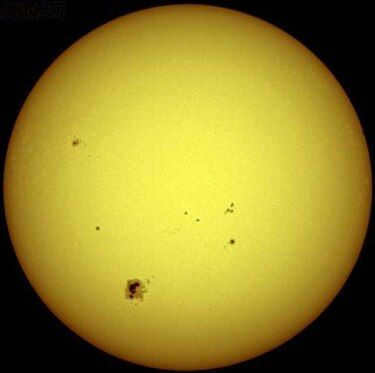 | |
| The Sun has three main layers of its atmosphere: the photosphere, the chromosphere, and the solar corona. | ||
| The Sun also has an extended structure, including the heliosphere, the heliospheric current layer, the shock wave boundary, the heliospheric mantle, the heliopause, and the head shock wave. | ||
| There are many phenomena related to the Sun, such as solar eclipses, solar activity (including sunspots, solar flares, and coronal mass ejections), solar radiation variations, coronal holes, coronal loops, flares, granules, floccules, protuberances and fibers, spicules, supergranulation, solar wind, and Morton’s Wave. | ||
| Some related topics include the solar system, solar dynamo, and stellar evolution. | ||
| Spectral class: G2 | ||
Wikimedia Foundation. 2010.
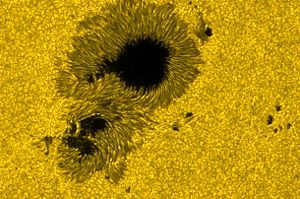
The picture displays a collection of sunspots, which were captured in visible light by a spacecraft on December 13, 2006.
Sunspots are dark regions on the surface of the Sun, where the temperature is approximately 1500 K lower than the surrounding areas of the photosphere. These spots can be observed on the Sun’s surface, either with optical instruments or, in the case of larger spots, with the naked eye. They appear as dark spots. Sunspots are formed by the emergence of strong magnetic fields (up to several thousand gauss) into the photosphere. The darkening of the photosphere in sunspots is a result of the suppression of convective motions caused by the magnetic field. This suppression leads to a reduction in the heat energy transfer flux within these regions.
The count of sunspots (and the corresponding Wolf figure) serves as a primary gauge of solar magnetic activity.
Cooler stars, such as those classified as K-class or cooler, exhibit significantly larger sunspots compared to our Sun. [1]
Frequency
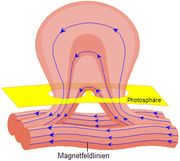
The duration of spot existence can extend to several months, meaning that individual spots can be observed over multiple rotations of the Sun. It is this particular fact (the movement of observed spots across the solar disk) that has provided the evidence for the Sun’s rotation and allowed for the initial measurements of its axial revolution period.
Spots typically form in clusters, although occasionally there may be a solitary spot that only lasts for a few days, or two spots with magnetic lines connecting them.
In a dual spot formation, the first spot is referred to as the P-spot (preceding) and the older spot is known as the F-spot (following).
Only half of the spots persist beyond two days, and a mere tenth of them survive the 11-day threshold.
Groups of spots always align parallel to the solar equator.
Characteristics
The Sun’s surface possesses a mean temperature of approximately 6000 C (5770 K effective temperature, 6050 K radiation temperature). The central area of the sunspots, which is the darkest, exhibits a temperature of approximately 4000 C, while the outer regions adjacent to the normal surface range between 5000 and 5500 C. Despite the lower temperature of the sunspots, their material still emits light, albeit to a lesser degree compared to the rest of the surface. The discrepancy in temperature is what causes the sunspots to appear as dark, nearly black regions, although in reality they also emit light, but it is overshadowed by the brighter solar disk.
Spots on the Sun represent the areas with the highest level of activity. When there are numerous spots, the chances of magnetic lines reconnecting increase. These lines, which originate from different spot groups with opposite polarity, combine together. This process leads to the formation of solar flares. When radiation from these flares reaches the Earth, it disrupts the planet’s magnetic field, causing significant disturbances. Satellites may experience malfunctions, and objects on the planet can be affected as well. Furthermore, the disturbances in the magnetic field also enhance the possibility of observing the northern lights at lower latitudes. Additionally, the Earth’s ionosphere undergoes fluctuations due to solar activity, resulting in changes in the propagation of short radio waves.
During periods of low sunspot activity, the Sun’s size experiences a reduction of 0.1%. The period from 1645 to 1715, also known as the Maunder minimum, is notable for its global cooling effects, earning it the name of the Little Ice Age.
Categorization
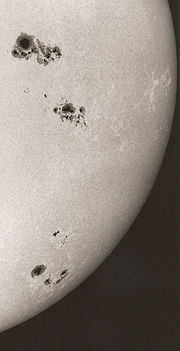
The classification of spots is determined by their duration, size, and placement.
Phases of growth
As previously mentioned, the local strengthening of the magnetic field hinders the movement of plasma in convection cells, resulting in a decrease in heat transfer to the surface of the sun. The cooling of the granules impacted by this process (by approximately 1000 C) causes them to darken and form a singular spot. Some of these spots disappear after a few days, while others develop into bipolar groups consisting of two spots with opposing magnetic polarity. These groups can further combine to create larger clusters of spots, eventually forming shadows known as penumbra that can encompass hundreds of spots and reach sizes of hundreds of thousands of kilometers. Following this stage, there is a gradual decline in spot activity over several weeks or months, leading to a reduction in size and the formation of smaller double or single spots.
The biggest clusters of sunspots are always accompanied by a corresponding cluster in the opposite hemisphere (either northern or southern). In these cases, magnetic lines flow out of the spots in one hemisphere and into the spots in the other.
Periodicity
The solar cycle is connected to the frequency, activity, and duration of sunspots. Each cycle lasts approximately 11 years. During periods of low activity, there are very few or no sunspots on the Sun, while during periods of high activity, several hundred can be observed. At the end of each cycle, the polarity of the solar magnetic field flips, so it is more accurate to refer to a 22-year solar cycle.
The length of the solar cycle
Approximately 11 years is the typical duration of a solar cycle. However, the length can vary from 9 to 14 years. Over the centuries, the average length has also changed. For instance, in the 20th century, the average cycle was 10.2 years. The occurrence of the Maunder minimum and other activity minima suggest that it is possible for the cycle to extend to around a hundred years. Analysis of the Be 10 isotope in Greenland ice indicates that there have been more than 20 such prolonged minima in the past 10,000 years.
The duration of the cycle is not fixed. Swiss astronomer Max Waldmeier proposed that the transition from minimum to maximum solar activity happens faster when there is a higher maximum number of sunspots recorded in that particular cycle.
The start and conclusion of a cycle

In the past, the start of a cycle was defined as the time when solar activity reached its lowest point. With the help of advanced measurement techniques, it has now become possible to determine the shift in polarity of the solar magnetic field. Therefore, the moment when the polarity of the sunspots changes is now considered as the initiation of the cycle.
The cycles are identified by a sequential number, beginning with the first one, recorded in 1749 by Johann Rudolf Wolf. The current cycle (April 2009) is designated as cycle 24.
| Information about recent solar cycles | |||
| Cycle number | Starting year and month | Maximum year and month | Maximum number of sunspots |
| 18 | February 1944 | May 1947 | 201 |
| 19 | April 1954 | October 1957 | 254 |
| 20 | October 1964 | March 1968 | 125 |
| 21 | June 1976 | January 1979 | 167 |
| 22 | September 1986 | February 1989 | 165 |
| 23 | September 1996 | March 2000 | 139 |
| 24 | January 2008 | December 2012 | 87. |
During the 19th century and up until around 1970, there was a theory that there was a recurring pattern of fluctuation in the highest number of sunspots. These cycles, which lasted for 80 years and had the lowest maximum sunspots between 1800-1840 and 1890-1920, are now believed to be caused by convection processes. Some other theories propose the existence of even longer cycles, lasting 400 years.
Literature
Wikimedia Foundation. 2010.
Valuable
Find out the definition of “Sunspots” in different dictionaries:
- Sunspots, in the sun, on the sun – Refer to … Dictionary of Synonyms
- Sun – Referring to the sun in the sky, drying one’s shoes under the sun, spots under the sun. Dictionary of Russian Synonyms and Expressions Similar in Meaning. Edited by N. Abramov, M.: Russian Dictionaries, 1999. sun, star, parhelion (closest to us),… … Dictionary of Synonyms
- Sun – This term has other meanings, see Sun (meaning). Sun … Wikipedia
- The Sun – 1. Movement and dimensions of the Sun. 2. Illumination and warmth of the Sun. 3. Techniques for observing the Sun. 4. Photosphere, granulation, sunspots, and solar flares. 5. Sun’s rotation. 6. Regularity of sunspot occurrence. 7. Connection between solar phenomena and terrestrial magnetism. 8. Chromosphere and prominences. 9. The Sun’s corona. 10. Hypothesis … F.A. Brockhaus and I.A. Efron’s Encyclopedic Dictionary
- Sun – [so/nz], a, s. 1) The Sun is a celestial luminary in the form of a colossal glowing plasma ball, around which our Earth and other planets orbit. It is the center of our solar system and is responsible for providing us with light and heat. The Sun rises in the morning and sets in the evening, marking the beginning and end of each day. It is a source of immense energy and is essential for life on Earth. This information is sourced from the Popular Dictionary of the Russian Language.
- Sun and Moon (Middle-earth) – In J.R.R. Tolkien’s lore, the Sun and Moon are the primary astronomical objects that have been created artificially. They appear in nearly all of his works and are described in detail in various versions. For more information, you can refer to Wikipedia.
- SOLAR – The SOLAR SYSTEM is centered around the Sun, a star that holds other celestial bodies in its orbit. The Sun’s movement across the sky and its yearly movement along the Ecliptic are a result of the Earth’s rotation…
- SOLAR – The Sun, also known as SOLNTSE, is the radiant and central body of our universe. It exerts its influence over all the planets and earthly worlds through the forces of gravity, light, and heat. In Slavic dialects, the Sun is referred to as slonce, slonko, and sontse… Dahl’s Explanatory Dictionary
- SUN – [he ], a, cf. 1. (in the terminological meaning C uppercase). A celestial luminary is a hot plasma body of spherical shape around which the Earth and other planets orbit. S. dwarf star. To determine the time by the sun (by its position in the sky) … Ozhegov’s Explanatory Dictionary
spontaneously materialize and vanish permanently
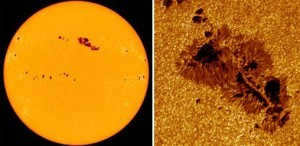
Centuries ago, our ancestors were able to observe black spots on the surface of the Sun. However, without the proper tools, they were unable to determine the origin of these spots. They questioned whether they were shadows cast by passing celestial bodies or if they were actually part of the Sun itself. It wasn’t until the 17th century that Galileo Galilei, using a homemade telescope, was able to confirm that the spots were indeed a feature of the Sun and that they rotated along with it. Despite this breakthrough, the true nature of these enigmatic spots remained a mystery for a significant amount of time.
Even in modern times, we are still unable to closely examine the physics behind these spots due to the immense distance between us and the Sun. Although there are numerous telescopes constantly observing the Sun, we are unable to get close enough to study the processes in detail. Theorists also continue to speculate in the absence of concrete evidence.
What are the dark spots on the Sun’s fiery surface?
Let’s begin with plasma. Solar plasma is a fully ionized gas and is referred to as “the fourth state of matter,” although this categorization is not accurate as plasma is actually the most common state of matter in the Universe. All stars are composed of plasma. Therefore, plasma is not the fourth state of matter but rather the first state of matter in nature.
Plasma, along with the free electric charges within it, creates a conductive medium for electric current, which causes it to interact with magnetic and electric fields.
According to Wikipedia, “Due to the excellent electrical conductivity of plasma, it is impossible to separate positive and negative charges at distances greater than the Debye length and times longer than the period of plasma oscillations” [1]. [1].
It is worth mentioning that under conditions of high plasma densities and strong convective flows, extended plasma bundles may arise, commonly referred to as “cords,” “rods,” “fibers,” “jets,” “magnetic tubes,” and now also “spicules.” These bundles serve as effective conductors of electric currents. As a result, powerful magnetic fields are generated around them, which in turn give rise to new electrical bundles. This is why we observe these bundles as distinctive strokes that form magnetic spirals in the images around the spots.
Visually, the spots appear black and cold against the backdrop of the photosphere, which has an effective temperature of 5778 K. However, their actual temperature is around 4500 K. The average depth of the spots is approximately 500 km.
The interaction between these bundles (conductors) results in the creation of a unique spatial structure around an imaginary center. This process is responsible for the formation of a dark region, commonly known as a black spot. The ionized substance from this central point is effectively drawn out into the surrounding bundles. As a result, the black spots expand rapidly. Since convective plasma flows rise from the core of the sun along radial paths, the formation of electric cords occurs in a radial direction. As the matter flows into the region of the spot, it is instantaneously broken down and absorbed by one of the surrounding harnesses. Consequently, the radiation at the center of the spot decreases significantly, leading to a decrease in temperature and rendering it invisible.
The expansion of the spot is actually caused by the electromagnetic interaction of parallel conductors carrying currents in the same direction. The conductors attract each other and, when arranged in a circle, cause the ring to expand. Initially, the plasma ring is unable to break due to the upward plasma flows from the Sun’s central regions. However, as it expands, the electromagnetic forces in the center weaken and convective flows start to penetrate into the upper layers of the photosphere, causing the plasma bundles to collapse. Consequently, this results in the dissolution of the spot.
Small spots can be created by plasma flows moving either upwards or downwards. When the flow is downward, the magnetic field of the spot will be reversed. However, these spots cannot persist for long due to the pressure from the convective flows originating from the Sun’s interior. Conversely, spots formed by upward flows can grow to enormous sizes and endure for approximately one month.
Sunspots have a direct impact on the climate and, as Chizhevsky argued, social phenomena.
Solar Flares: The Phenomenon of Solar Shaking
However, it is highly improbable that an elderly astronomer would exclaim, “There is a storm in the sun.” We have the ability to observe the sun directly, with our mouths agape and our eyes unwavering.
(Vladimir Vysotsky)
What exactly is a solar storm or solar flare? It is a topic of discussion, speculation, and anticipation. Yet, a precise definition eludes us.
One thing is certain, though – solar flares do not occur in the absence of sunspots.
During a powerful solar flare, there is a significant increase in the emission of ultraviolet, X-ray, and gamma rays. The radioactive photon radiation reaches Earth approximately eight minutes after the flare initiates. Within a few tens of minutes, streams of charged particles make their way to Earth, followed by clouds of electrons and protons two to three days later.
The ozone layer and the entire Earth’s atmosphere provide protection against lethal levels of radiation, while the geomagnetic field shields us from charged particles. However, it is impossible to achieve 100% protection from intense radiation, which makes solar flares a potential threat. These flares have the ability to damage satellites, expose astronauts to radiation, and impact airlines and power grids. Therefore, it is crucial to predict solar flares and gain a deeper understanding of their origins and characteristics.
“Solar flares typically occur at the interfaces of sunspots with opposite magnetic polarity, specifically near the neutral magnetic field line that separates regions of north and south polarity. The frequency and intensity of solar flares are influenced by the phase of the 11-year solar cycle” [2].
A flare is a burst of energy, with temperatures reaching up to 30,000 degrees Celsius. It is a brief phenomenon that typically lasts for about one minute. This information leads me to think about solar lightning. If the flare is particularly intense, the process of plasma illumination can persist for a significant period of time (ranging from tens of minutes to even hours). The duration of this spectacular event ultimately depends on the magnitude of the phenomenon.
Given that sunspots are inherently unstable occurrences in the photosphere, we can infer that a flare is the outcome of such transient processes. Essentially, a solar flare represents the most potent form of lightning! What exactly do I mean by “most powerful”? In this context, I am referring to the sum of multiple elementary lightning strikes occurring in parallel. It is essentially an immense surge of ionized particles that are discharged in a single burst, ultimately counteracting the pressure exerted by the Sun.
Actually, each of these harness-conductors is composed of individual lightning bolts, but against the overall brightness of the photosphere, they appear as lighter shades and ripples.
The magnetic lines (as seen in the image below), along which the charged plasma particles surge, exhibit minimal deviation and ascend. This demonstrates the immense size and strength of the sunspot’s magnetic field. The image captures the onset of a flare on the sunspot’s periphery.
During such a lightning strike, there is a powerful release of gas pressure in the plasma, followed by the ejection of coronal plasma and a sunquake.
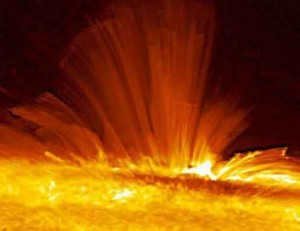
A sunspot captured by the solar space observatory Hinode in a frontal view[1]. Plasma ejections occur along curved magnetic field lines.
Unlike earthquakes, which generate short bursts of waves on Earth, solar lightning produces continuous seismic noise and intense sunquakes within the Sun’s interior, all thanks to solar lightning. However, due to the plasma nature of solar matter, the seismic waves quickly dissipate.
Solar flares are extraordinary and potent releases of thermal, kinetic, seismic, and light energy from the Sun.
Moiré pattern on the surface of the Sun
If there was an abundant supply of oxygen on the Sun, particles resembling ash would continuously descend onto our planet, similar to volcanic eruptions.
In relation to this, I would like to present an additional innovative idea, which I will introduce with a query: What type of granules (cells) do we perceive from Earth when observing through a telescope? When observing the Sun at significantly high magnification, its surface appears to us as a moiré pattern of granularity.
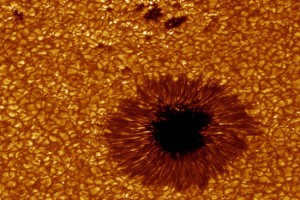
The solar surface has a granular structure, with a central dark spot.
The image displays distinct cells with various shapes, surrounded by dark borders.
What are these granular cells and where do they originate from?
Solar plasma can be likened to a simmering broth. This analogy is quite fitting, as it provides a visual representation on a smaller scale – the surface of the sun. Just like when we boil a meat broth on a stove, we observe streams of liquid rising and scattering scale in different directions. If we were to take an overhead picture of our broth, it would resemble the image above.
Through the experience of using meat broth, I guide the reader to the concept that there is a scale present at the edges of the solar pellets! This scale is formed by the combustion products, which include ash. As depicted in the photograph, the pellets have a lighter hue in the center and a darker hue closer to the edges. This supports the analogy to a broth, where the central part of the grains rises above the periphery. The differences in height can reach up to tens of kilometers, despite the average diameter of the granules being 1000 km. This is the nature of the solar plasma, resembling a bubbling and coagulating broth.
The solar surface can be observed with even greater clarity by viewing a rainforest from an aerial perspective. Due to the varying levels of illumination on the treetop canopies and the outer areas of the canopies, we are able to discern differences in altitude. Consequently, when gazing down upon a rainforest from above, one cannot help but contemplate that it resembles not a typical forest, but rather domed green hills of soil beneath.
If we apply this analogy to the Sun, we can envision its surface as colossal hills comprised of intensely bright plasma. These hills, known as granules, emerge as a result of convective upward currents, giving rise to distinctive columns of plasma.
Within the realm of the Sun, there exist sunspots, flares, and even sunquakes! While spots and flares can be visually observed, seismic activity can only be detected through the use of seismometers. The question then arises: who and how could such instruments be placed upon the Sun?
- Quasi-neutrality, http://m.bankreferatov.ru/referats/.doc.html
- Wikipedia, Solar flare, http://ru.wikipedia.org/wiki
[1] Hinode is a man-made satellite that was designed to investigate solar activity, magnetic field, and radiation in the ultraviolet and X-ray ranges. It is equipped with optical and X-ray telescopes, as well as an ultraviolet spectrometer. The device was developed by engineers from Japan, the United Kingdom, and the United States and was launched in 2006 from Japan’s Uchinoura Cosmodrome.
Similar Articles
5 Opinions
…If you’re fortunate, continue onward!
If you’re not fortunate, continue onward.
persevere.
Harald Sverdrup Ice Age. Throughout the history of our planet, there have been three ice ages. An ice age occurs during the formation of a new planet in our solar system. And there are three planets that were formed after Earth. They are Venus, Mercury, and the Moon. The period of cold on Earth arises as a result of the following process in our solar system. All the planets in our solar system are aligned on the equator of the sun. And during the formation of a new planet, a ring of gas and dust appears around the sun’s equator, from which a new planet is born. This ring is formed by black holes. A black hole is a space tube in which there is no ether and is truly empty, with no gravitational force. When a black hole emerges on the sun’s equator, gases and solar matter rush into it under immense atmospheric pressure from the sun’s surface. The main portion of this substance reaches a height from which it does not return to the sun, and it remains in orbit due to centrifugal forces. And as the gas-dust ring forms, the number of these black holes increases significantly. As time goes on, the density of the gas-dust ring increases, making it denser and darker. Consequently, a portion of the energy emitted by the Sun is trapped within this gas-dust ring. This causes Earth to enter a period of cold (ice age). This has happened twice, during the formation of the planet Venus and the formation of the planet Mercury. The third ice age occurred during the formation of our satellite planet, the Moon. However, the material provider for the Moon was the planet Earth. The birth of the Moon followed the same sequence as the birth of Venus and Mercury. A ring of gas and dust around the Earth prevented solar energy from reaching the Earth. And after this ring of gas and dust formed the Moon, the Earth experienced “global warming”. It is not necessary to seek the obligatory fulfillment of all physical laws discovered on Earth, as the level of cosmic thinking is many times higher than that of a human being. One should simply observe the fact and attempt to find an explanation for it. Egor Chemezov-Nukuty-Irk.oblast-December 5, 2013 – chemezov.umi.ru
Not everyone is fortunate enough to receive help by chance. Fate only smiles upon those who are prepared. – Louis Pasteur. Sunspots are a topic of great interest, and in this article, I propose a new hypothesis regarding their formation. For a long time, space was believed to be empty, devoid of any substance. However, this raised questions about how light from the Sun and distant stars reaches the Earth, as well as the carrier of radio waves in space. After all, in a completely empty void, not only sound but also light cannot propagate. Nowadays, it is widely accepted that space is filled with a form of energy, often referred to as ether. It is through the presence of this ether that we observe the harmonious development of the material world. Unfortunately, we are yet to witness the development of the non-material world, and its actions often frighten and shock us. In this article, I aim to shed light on one of the mysteries occurring within the ether. The ether surrounding us does not have a uniform density, and for some unknown reason, there are “black holes” within it. These black holes are tubes within the ether where neither ether nor gravity exist. Black bubbles also traverse through space, and if the Earth were to encounter one of these bubbles, life on our planet would cease instantaneously. However, the creator of Earth also serves as its protector. The black, dark spots on the Sun are actually created by these black holes and bubbles. When a black hole intersects the Sun, with one end directed towards the Earth, we observe a black spot on the Sun. The length of the black hole determines the darkness of the spot. It is already known that there is no gravity within a black hole. Therefore, under high atmospheric pressure, gases and solar matter from the surface of the Sun rush into the black hole. The longer the black hole, the more gases reach the Earth. Regardless of the magnitude of the explosion on the Sun’s surface, no molecule can overcome the Sun’s gravity. If we observe a dark spot on the Sun without any emission of solar gases towards the Earth, it signifies the presence of a black bubble floating above the Sun’s surface. As we already know, black bubbles are not conductors of magnetic vibrations, such as light. It is important not to confine ourselves to the physical laws discovered on Earth, as the level of cosmic thinking surpasses that of a human being. Instead, we must observe the facts and strive to find explanations. – Egor Chemezov-Nukuty-Irk.oblast-December 5, 2013.
“The level of cosmic thinking is significantly higher than that of humans, so it is not necessary to expect all physical laws discovered on Earth to be fulfilled here. Instead, we should acknowledge the fact and attempt to find an explanation for it.”
Dear Egor Chemezov, your statement contradicts itself. It appears that you are unfamiliar with the concept of a “Black Hole.” Such a phenomenon has not been observed on planet Earth. However, you assert that a black hole has penetrated the Sun and reached Earth.
Hello Genadi.
Here are some instances of black holes (gravity wells) manifesting on Earth. It is important to note that Earth is under the special protection of the forces responsible for creating humanity. It is possible that the Malaysian airplane on 07.03.14 was propelled into space by a black hole.
TORNADOES ARE THE RESULT OF GRAVITY WELLS.
Indeed, it is quite evident that the only plausible explanation for the disappearance of the Malaysian airplane would be the intervention of a Black Hole! However, it appears that the size of the hole was insufficient to accommodate one of the wings.
Share your thoughts
This website utilizes Akismet to effectively tackle spam. Discover the procedures employed to handle your comment data.
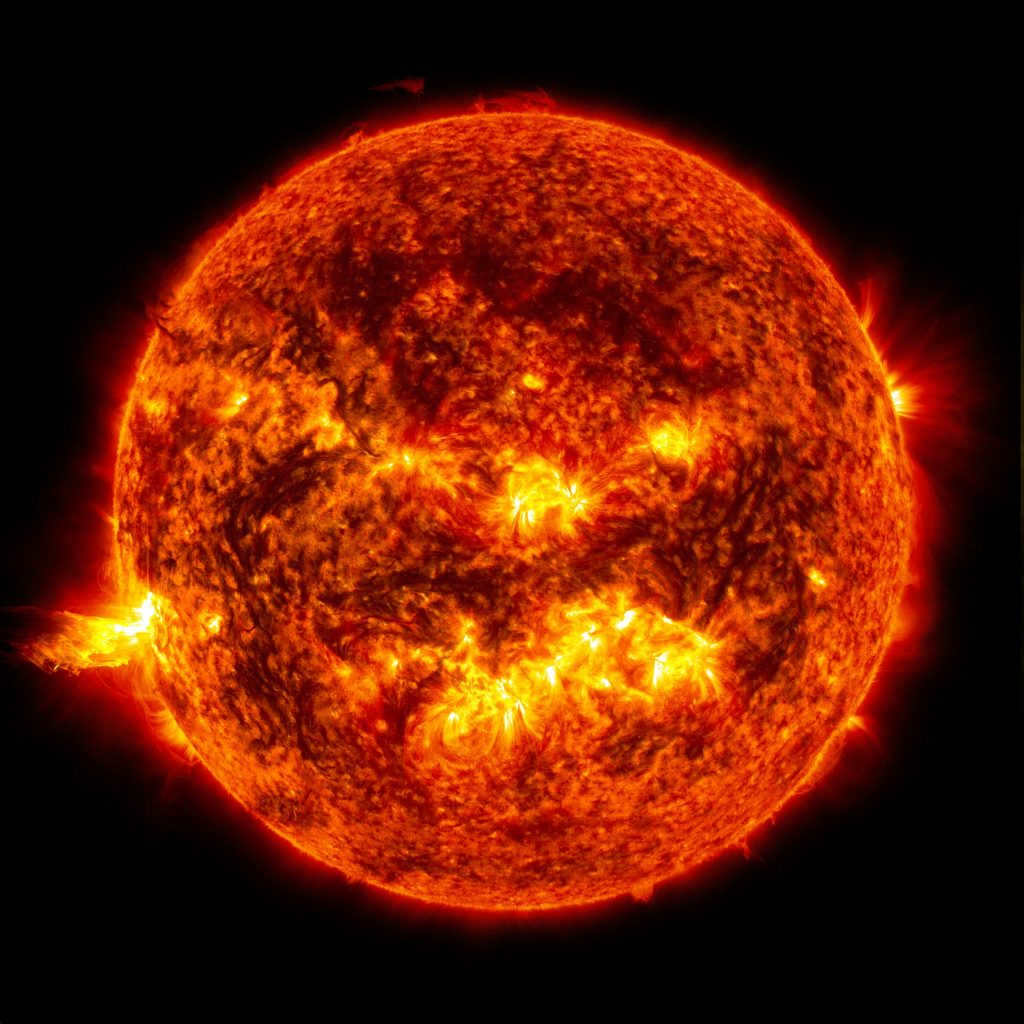
The Sun is an enduring celestial body, however, it experiences periodic displays of dynamism on its exterior – known as sunspots, flares, and prominences. These phenomena occur due to the emergence of the star’s loop-shaped magnetic fields onto its surface.
The characteristics of the spots
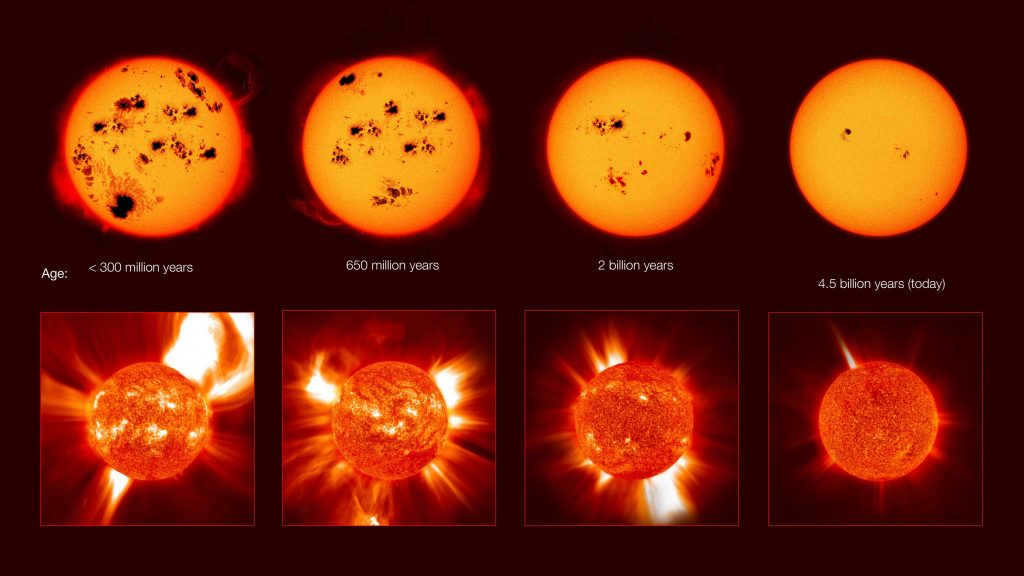
The process begins with the emergence of a visually brighter area on the surface. As time passes, this area expands and its brightness decreases. Subsequently, small dark spots known as pores, with sizes measuring just a few thousand kilometers, appear on the surface. These spots gradually grow and merge, forming what is commonly referred to as sunspots. In comparison to the surrounding surface, these spots are colder by two or three thousand degrees (the average temperature of the Sun’s surface being six thousand degrees).
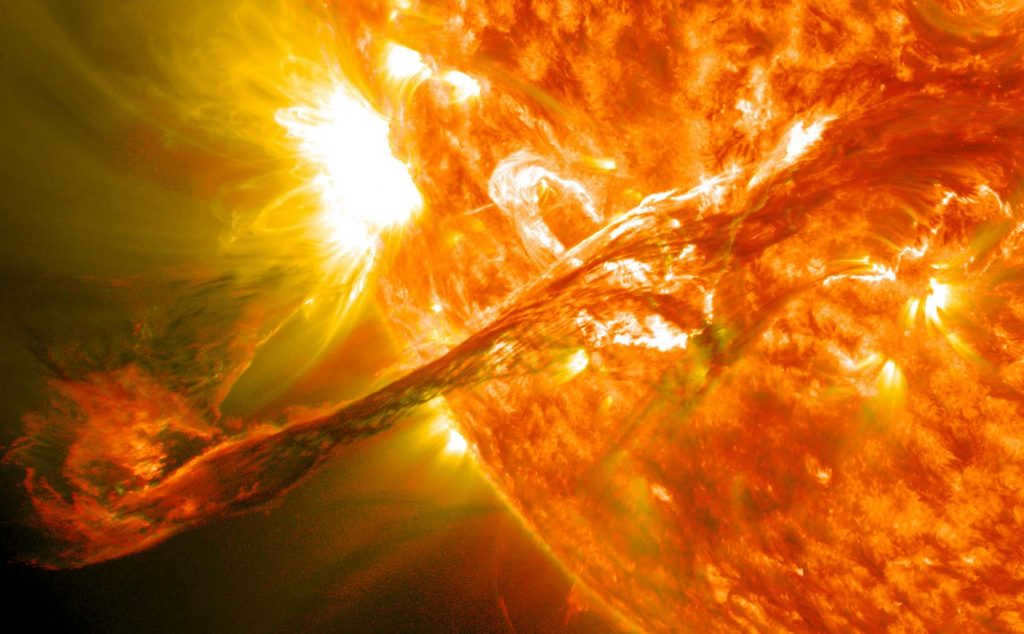
Following this, the magnetic loop proceeds to expand outward and attracts the heated ionized gas – plasma, resulting in well-known structures – prominences, exquisite loops of glowing gas, which hang above the visible surface of the Sun for periods of time, before gracefully descending back into the tumultuous abyss of boiling gas.
The primary characteristic of these loops’ magnetic fields is their strength, which can be measured using various techniques.
Investigation
Direct study of magnetic fields is unattainable due to the vast distance to the Sun and the extreme temperatures that surpass the capabilities of any apparatus. Consequently, researchers must resort to indirect means. Spectroscopic observations serve as the primary method of investigation.
Resources related to the subject
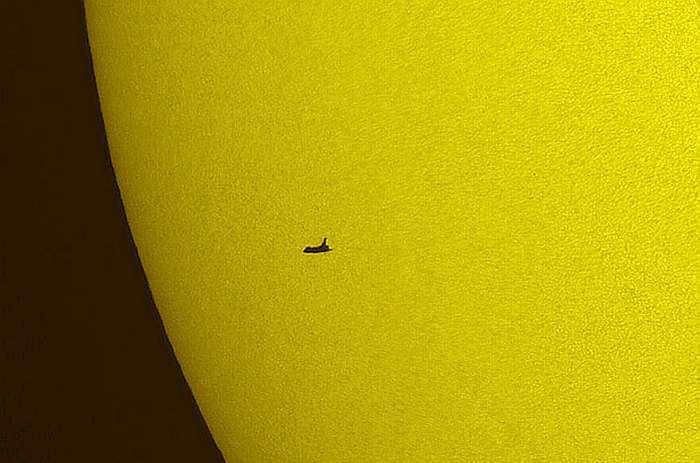
The main idea is that when subjected to a magnetic field, the main lines in the spectrum of the object being studied divide into multiple components. These components produce light that is polarized in different directions. This division is known as the Zeeman effect, and its extent is determined by the intensity of the magnetic field. In order to examine the divided components, a specialized polarizer is positioned in front of the spectrograph slit, which separates the components and presents the division on the spectrogram.
Currently, there are numerous telescopes in operation worldwide that observe the precise splitting of spectral lines in the Sun’s spectra. Through the analysis of these spectra, scientists can gather valuable insights not only into the origin and characteristics of the active zone but also into the internal structure of the Sun. This, along with helioseismology, serves as an indirect means of studying the Sun’s deep layers. Conversely, direct methods of exploration are understandably unattainable.
Importance
The significance of these studies extends beyond pure scientific curiosity. In addition to providing valuable insights into the Sun, scientists also gain a wealth of information about its influence on Earth and our civilization. The magnetic fields emanating from the depths of the star do not simply end there, but continue to travel and often interact with our planet.
We perceive this phenomenon as magnetic storms, which have a profound impact on the free electrons within all matter on Earth – including both electronic devices and the human body. This influence operates at a molecular level, affecting the delicate sensors of various devices and the physiological processes of the human body. During periods of intense solar activity, there is a rise in the occurrence of heart attacks, strokes, and overall complaints of metabolic disorders. Unlike statistical analyses of factors such as Wolf numbers, studying the magnetic fields of solar emissions not only allows us to predict changes in the magnetic influence of our sun, but also provides explanations for it. As a result, these studies are highly sought after within the field of solar research.
In this image of the Sun, you can observe sunspots. These black spots on the surface are visible from Earth even without the use of a telescope. Galileo was the first to observe them through a telescope, but until recently, astronomers were unable to explain their origins.
What makes them appear dark?
Although the spots appear darker than the surrounding areas of the Sun, they are actually extremely hot. Their temperature can reach over 3,500 degrees Kelvin, yet they are not as bright as the Sun’s surface, which is heated to 5,800 Kelvin. Due to this temperature difference, they appear dark in comparison to the rest of the Sun’s surface. Some of these spots can be so large that the Earth could fit inside them. The Sun is mainly composed of plasma.
The movement of plasma within the Sun generates a powerful magnetic field that is similar to Earth’s magnetosphere.
However, the magnetic field of the Sun is in a constant state of flux. Scientists theorize that the magnetic field lines become entangled and extend beyond the surface of the Sun. These lines originate from locations where the magnetic field breaches the photosphere. Despite their appearance of darkness, they are actually only slightly cooler than the surrounding photosphere.
Current Sunspot Activity as Seen from the SDO Satellite
Check out the latest map of the magnetic field on the surface of our sun. This photo is updated on a daily basis, allowing you to stay up to date with the sunspot activity. The numbers on the map represent the different groups of sunspots.
